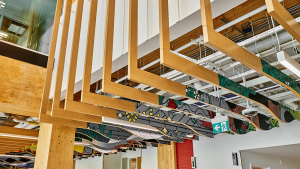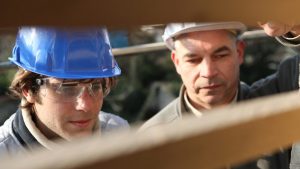This year’s TimberFever, the design-build competition between architectural and engineering students from various universities, is taking a sharp turn from a largely hands-on event to a virtual one because of the COVID-19 pandemic.
“We basically had to redesign the competition from scratch…to go online,” says Chris Cleland, the architectural chair of the sixth annual event which runs Sept. 24 to 27 at Ryerson University in Toronto.
He says organizers initially thought this year’s event would have to be cancelled or postponed because of the coronavirus before the idea of going virtual was raised.
“There’s a whole other aspect to building with timber and that’s both architectural and engineering design,” Cleland says.
This year students are competing from 14 universities, including several U.S. schools.
Toronto-based Moses Structural Engineers Inc. was instrumental in launching TimberFever years ago and continues to host the annual event. Its principal, David Moses, says COVID-19 has forced designers to collaborate online using a variety of tools.
We want the designs to test what the wood is capable of,
— David Moses
Moses Structural Engineers Inc.
While students were required to use engineering and architectural software in past years, in 2020 students “are taking the project model to more detailed level in a virtual world,” he adds.
“It’s not just CAD, but it’s how to interact with each other, and sketch on each other’s screens, and chat, share images/ideas to inspire each other and move the design along.
“Virtual TimberFever has all of those elements and is at the leading edge of this transformation in design practice,” Moses points out.
The design submissions will be done in “a virtual Gould Street setup” — the street on the downtown Ryerson campus where past events have taken place — and viewed on the TimberFever website.
Students in teams will collaborate through Zoom on the design model.
Mentors will be from Ryerson, Carpenters’ Local 27, B+H Architects, Moriyama & Teshima Architects, Partisans, George Brown College, EllisDon, Moses Structural Engineers, DTAH and U.S. universities.
“We want the designs to test what the wood is capable of. We don’t have limitations this year of wood craftsmanship, we have just wood design,” explains Moses.
He adds the online event allows projects to be “much larger” than previous years because there are no physical constraints. Still, judges will “be looking for efficient use of materials and constructability.”
First, second and third-place teams will be given cash prizes. There will also be an award for the “community favourite,” says Cleland.
He describes the virtual experience as closer to the “real world” setting where engineers and architects use programs like Rhino (Rhinoceros3D for architectural design) and RSTAB for calculations.
But building virtually is not a replacement for the “personal interaction” of the physical event, cites Moses.
“We need to work hard on student engagement and the psychological differences of working remotely while participating in an intense competition.”
He says in a virtual environment it is “twice as hard to communicate,” so helping the teams iron out issues so they can to learn to help themselves is a priority.
This is the first year that U.S. universities will be participating in TimberFever, made possible by the online format.
While this year’s theme won’t be announced until Sept. 24, the event will be focussed on issues prevalent in current times, Moses says.
This is Cleland’s third year with TimberFever.
In 2018 the 21-year-old was a contestant and the following year he was on the executive team organizing the event.
“Just being able to see other people put things together…manufacturing them from scratch has taught me a lot, especially when I competed,” he says.
The architectural chair says he is not sure how future years will shape after this year’s virtual format but he believes 2020 could offer a future of “a hybrid physical/virtual event mixing the best of both worlds.”
Cleland was raised in a 150-year-old farmhouse “that my parents were constantly renovating.” Watching them build an addition from the ground up “was really informing, really cool and probably made me decide to be an architect.”











Recent Comments
comments for this post are closed